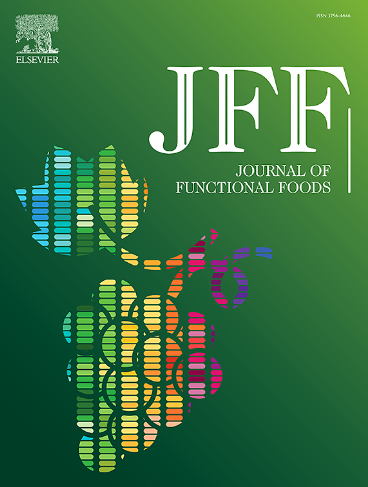药用和食用木叶桤木不同部位次生代谢产物及抗氧化活性的研究
IF 3.8
2区 农林科学
Q2 FOOD SCIENCE & TECHNOLOGY
引用次数: 0
摘要
木叶高寒被广泛用于中药和食品的生产,其传统的可食用部分以种子为主,对非药用部分壳和叶的开发较少,造成资源的严重浪费。本研究采用UHPLC-QTRAP-MS/MS对中国主要产区的4批木香植物材料及其药用部位和非药用部位的种子、壳和叶的化学成分进行了分析,采用水蒸气蒸馏法测定了其精油含量(EOC),总黄酮含量(TFC)、总多酚含量(TPC)、总多糖含量(TPSC)、药用部位含量(TFC)、药用部位含量(TPC)和药用部位含量(TPSC)。紫外分光光度法测定其体外抗氧化活性,典型相关分析法分析其化学成分与抗氧化活性的关系。结果表明,从木香3个部位共鉴定出1216种代谢物,其中传统非药用部位与药用部位代谢物差异仅136种,且非药用部位在TPC、TFC、TPSC及体外抗氧化活性方面均优于传统药用部位,仅EOC低于种子;体外抗氧化活性与代谢产物中TFC和TPC含量呈显著正相关。本研究表明,木香非药用部位的壳和叶也具有良好的开发应用前景,为木香的综合开发利用提供了科学依据。本文章由计算机程序翻译,如有差异,请以英文原文为准。

Secondary metabolites and antioxidant activity of different parts from the medicinal and edible Alpiniae oxyphylla Miq
Alpinia oxyphylla Miq. is widely used in the production of Chinese medicine and food, and its traditional edible parts are mainly seeds, with less exploitation of the non-medicinal parts shells and leaves, resulting in a serious waste of resources. In this study, four batches of plant materials collected from the main producing areas of A. oxyphylla in China, and the chemical components of seed, shell and leaf from medicinal and non-medicinal parts of them were analyzed by UHPLC-QTRAP-MS/MS, essential oil content (EOC) were determined using water vapor distillation, and the total flavonoids content (TFC), total polyphenols content (TPC), total polysaccharides content (TPSC), and antioxidant activities in vitro were evaluated using UV spectrophotometry, the relationship between chemical components and antioxidant activities were analyzed by canonical correlation analysis. The results showed that a total of 1216 metabolites were identified from the three parts of A. oxyphylla, and only 136 metabolites differed between the traditional non-medicinal and medicinal parts, and the non-medicinal parts was superior to the traditional medicinal parts in terms of TPC, TFC, TPSC and in vitro antioxidant activity, only the EOC was lower than that of the seeds, and the in vitro antioxidant activity of the A. oxyphylla was significantly and positively correlated to the content of TFC and TPC in the metabolites. This study showed that the shells and leaves of the non-medicinal parts of A. oxyphylla also have good prospects for development and application, providing a scientific basis for the comprehensive development and utilization of A. oxyphylla.
求助全文
通过发布文献求助,成功后即可免费获取论文全文。
去求助
来源期刊

Journal of Functional Foods
FOOD SCIENCE & TECHNOLOGY-
CiteScore
9.60
自引率
1.80%
发文量
428
审稿时长
76 days
期刊介绍:
Journal of Functional Foods continues with the same aims and scope, editorial team, submission system and rigorous peer review. We give authors the possibility to publish their top-quality papers in a well-established leading journal in the food and nutrition fields. The Journal will keep its rigorous criteria to screen high impact research addressing relevant scientific topics and performed by sound methodologies.
The Journal of Functional Foods aims to bring together the results of fundamental and applied research into healthy foods and biologically active food ingredients.
The Journal is centered in the specific area at the boundaries among food technology, nutrition and health welcoming papers having a good interdisciplinary approach. The Journal will cover the fields of plant bioactives; dietary fibre, probiotics; functional lipids; bioactive peptides; vitamins, minerals and botanicals and other dietary supplements. Nutritional and technological aspects related to the development of functional foods and beverages are of core interest to the journal. Experimental works dealing with food digestion, bioavailability of food bioactives and on the mechanisms by which foods and their components are able to modulate physiological parameters connected with disease prevention are of particular interest as well as those dealing with personalized nutrition and nutritional needs in pathological subjects.
 求助内容:
求助内容: 应助结果提醒方式:
应助结果提醒方式:


